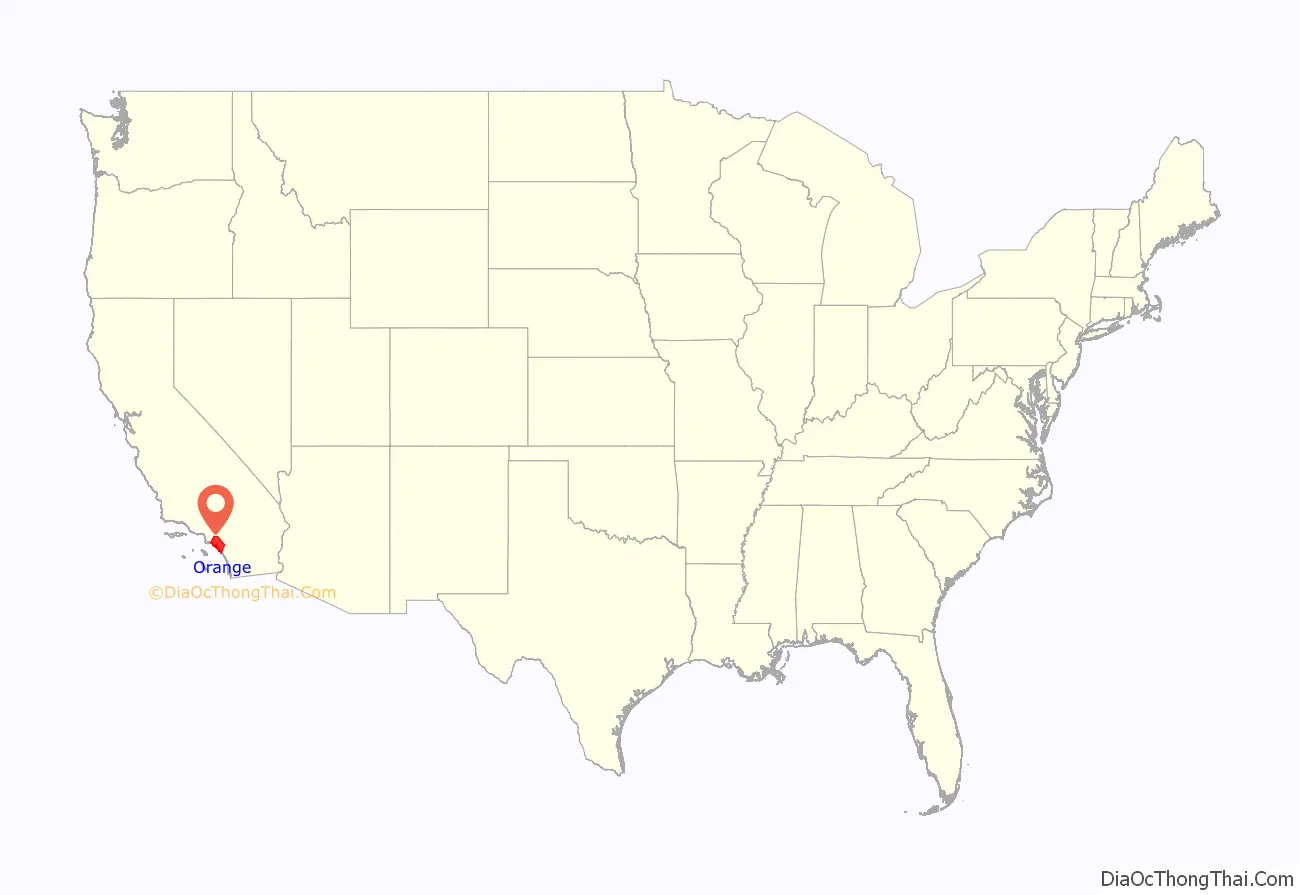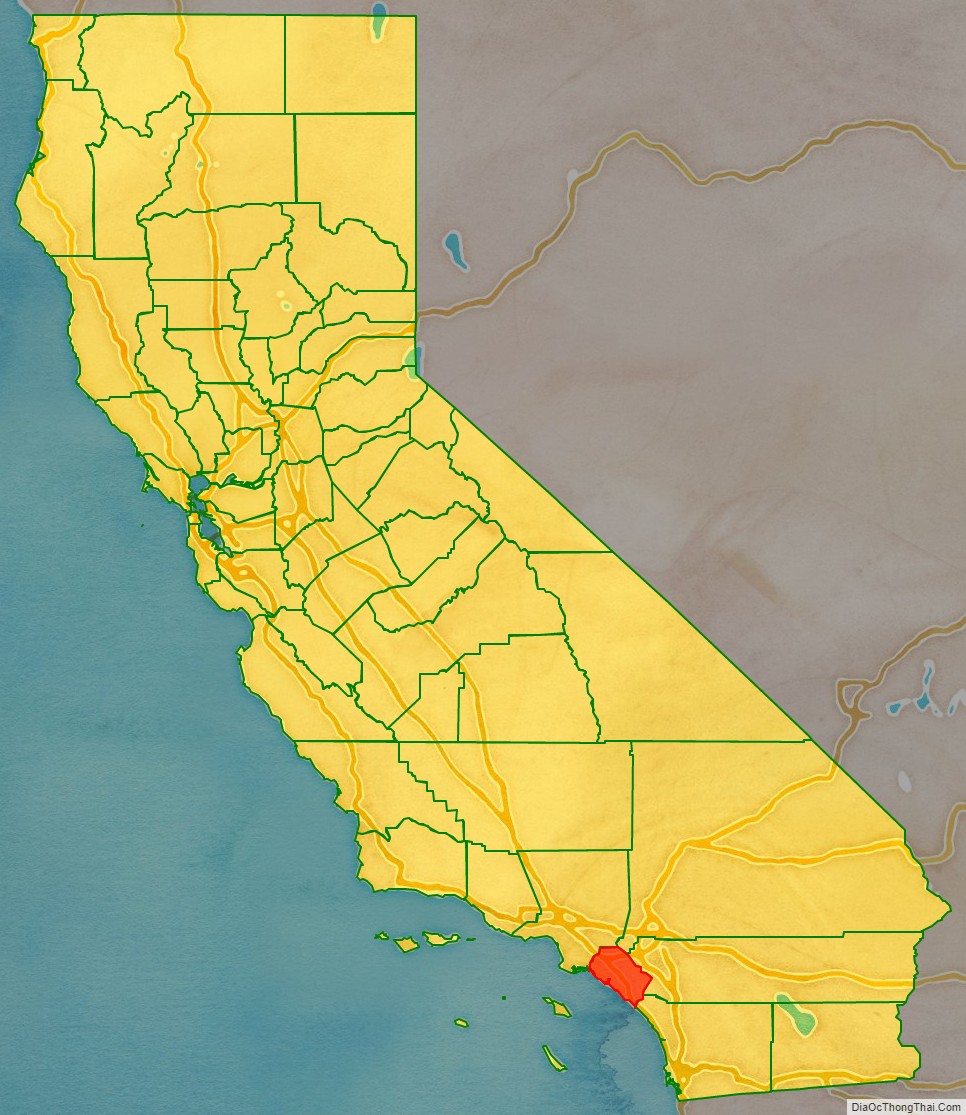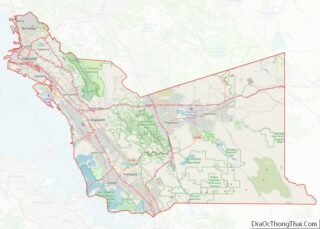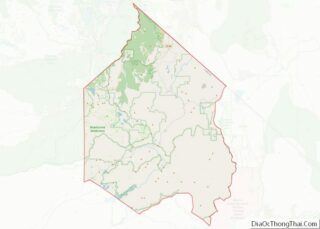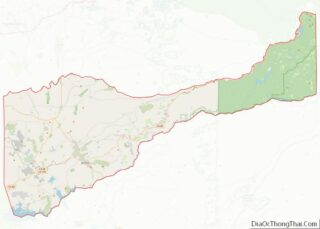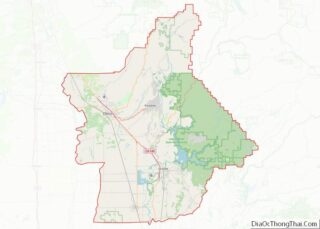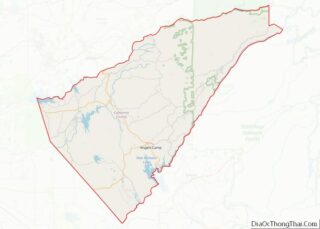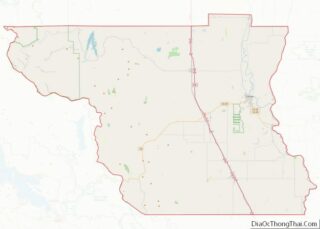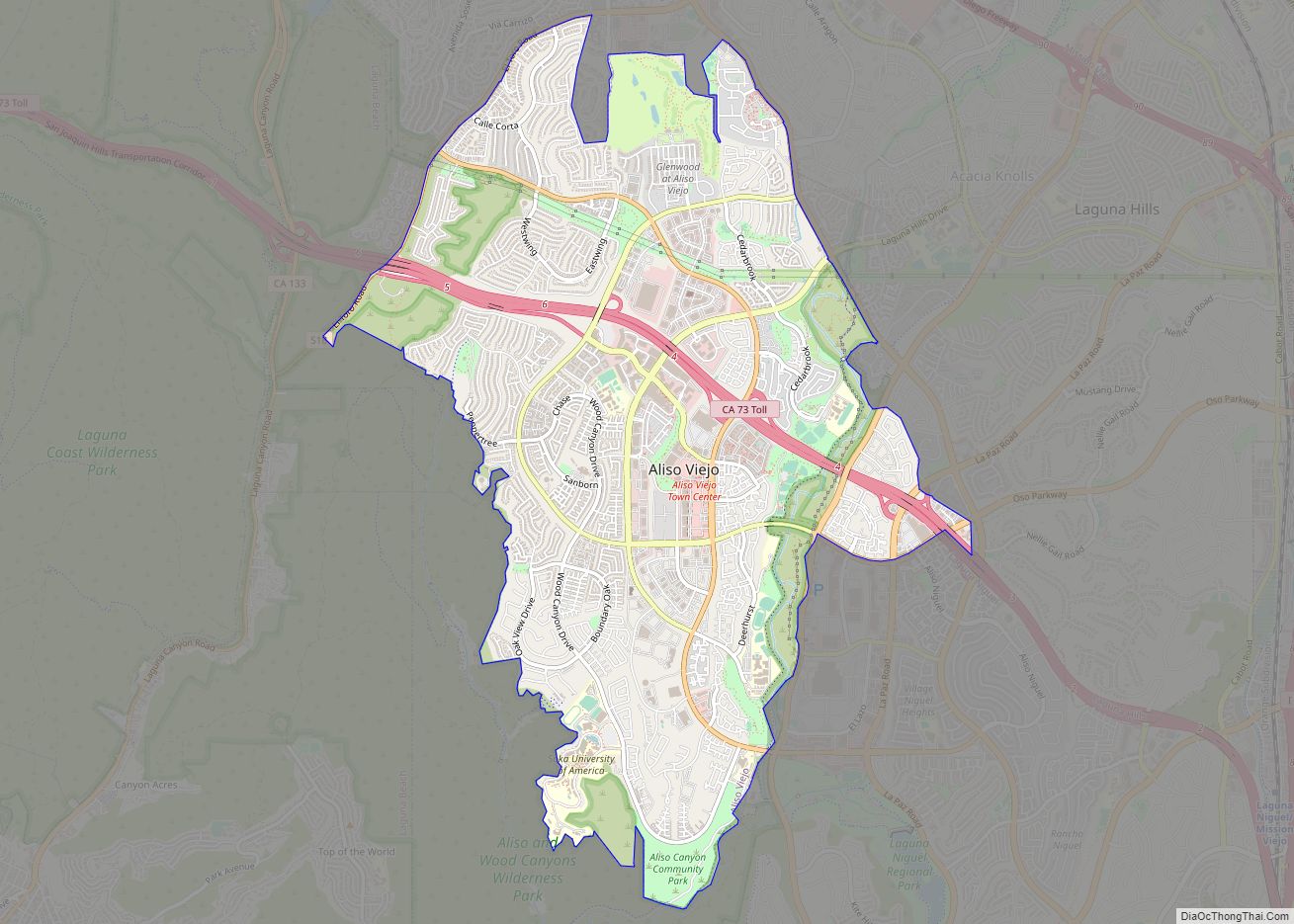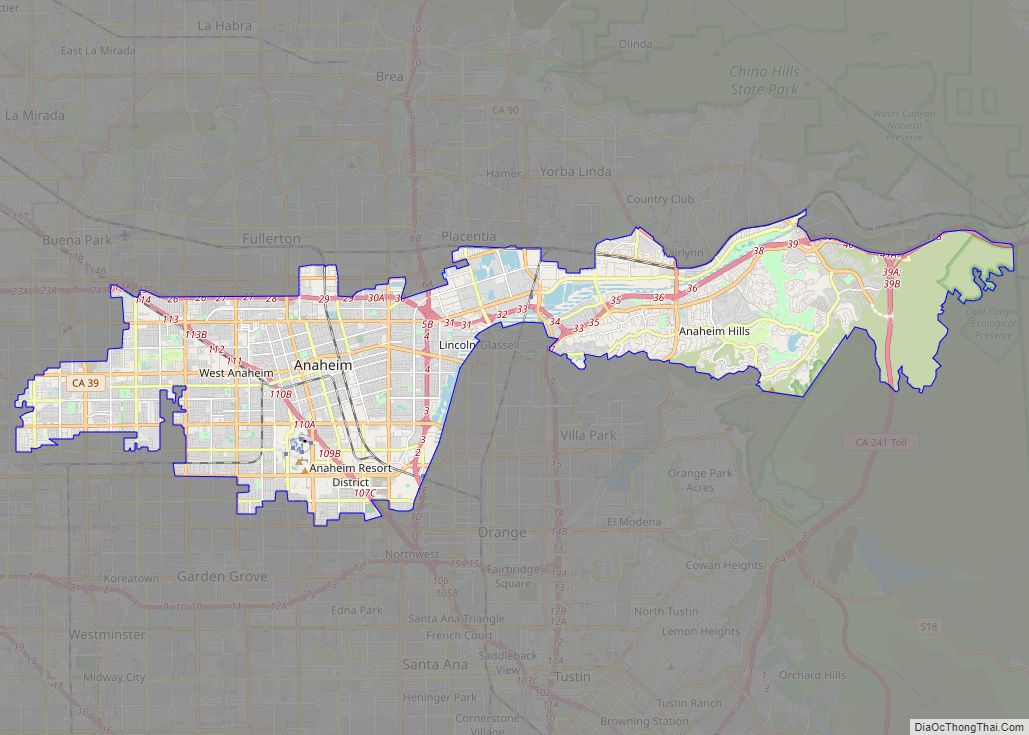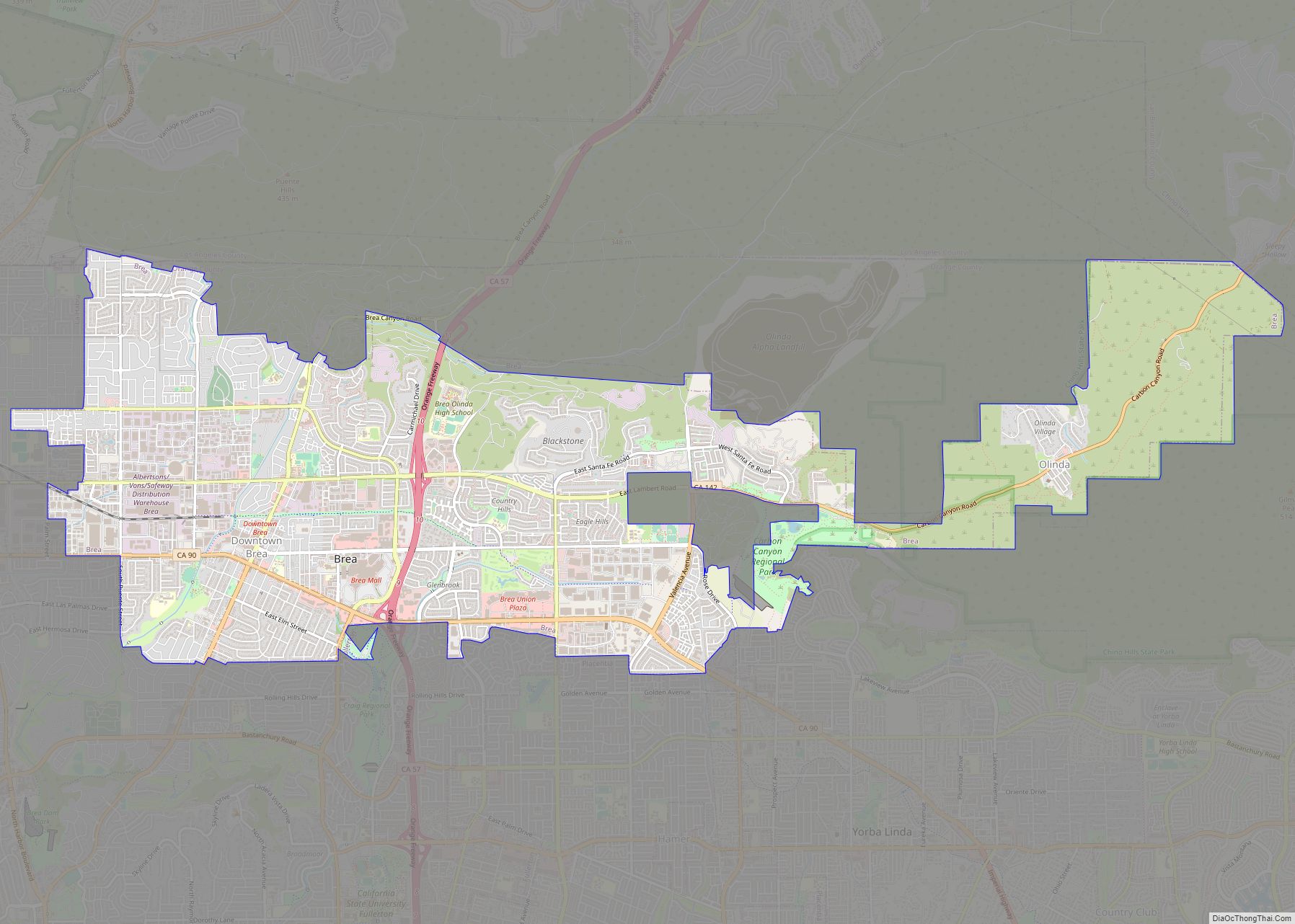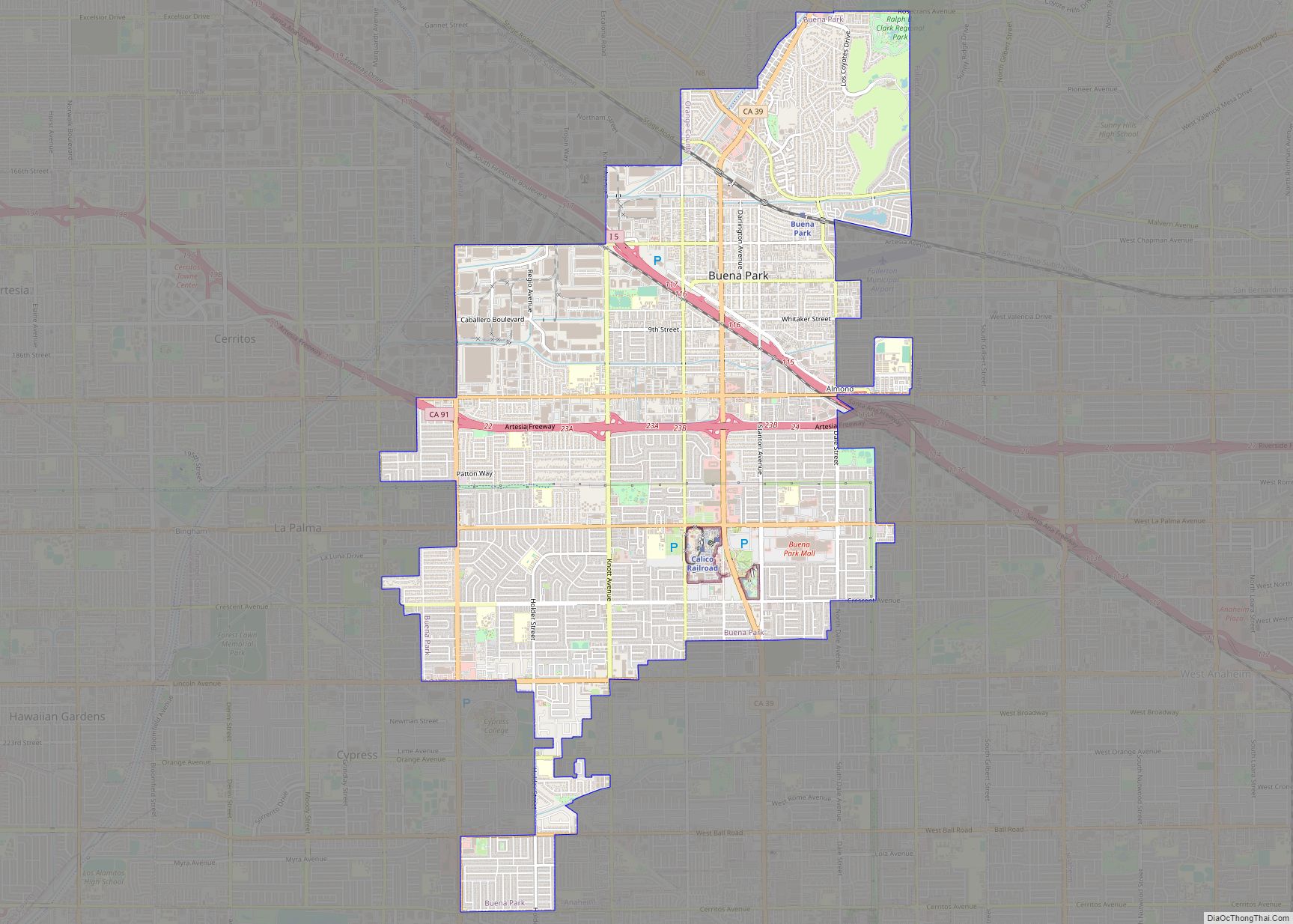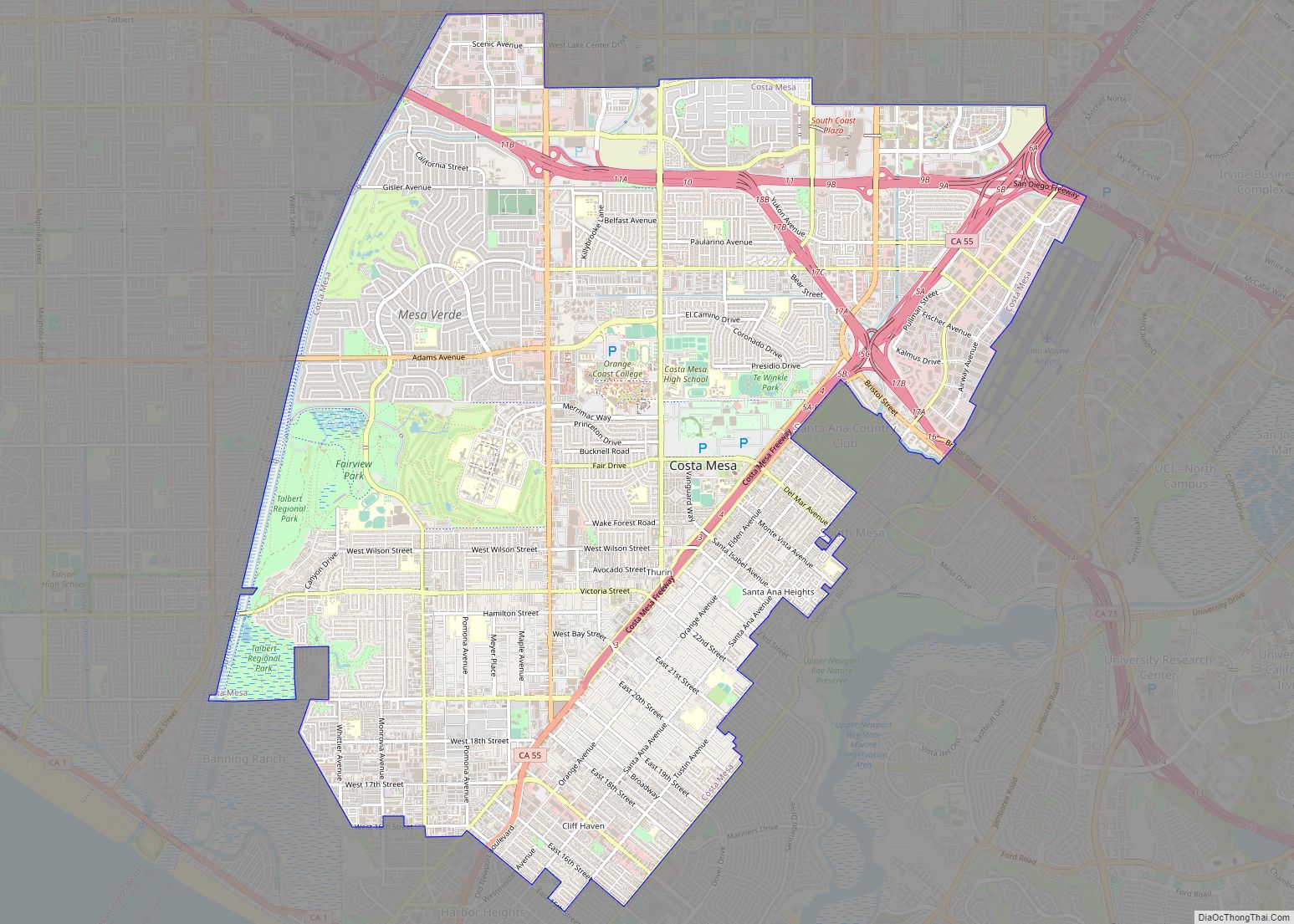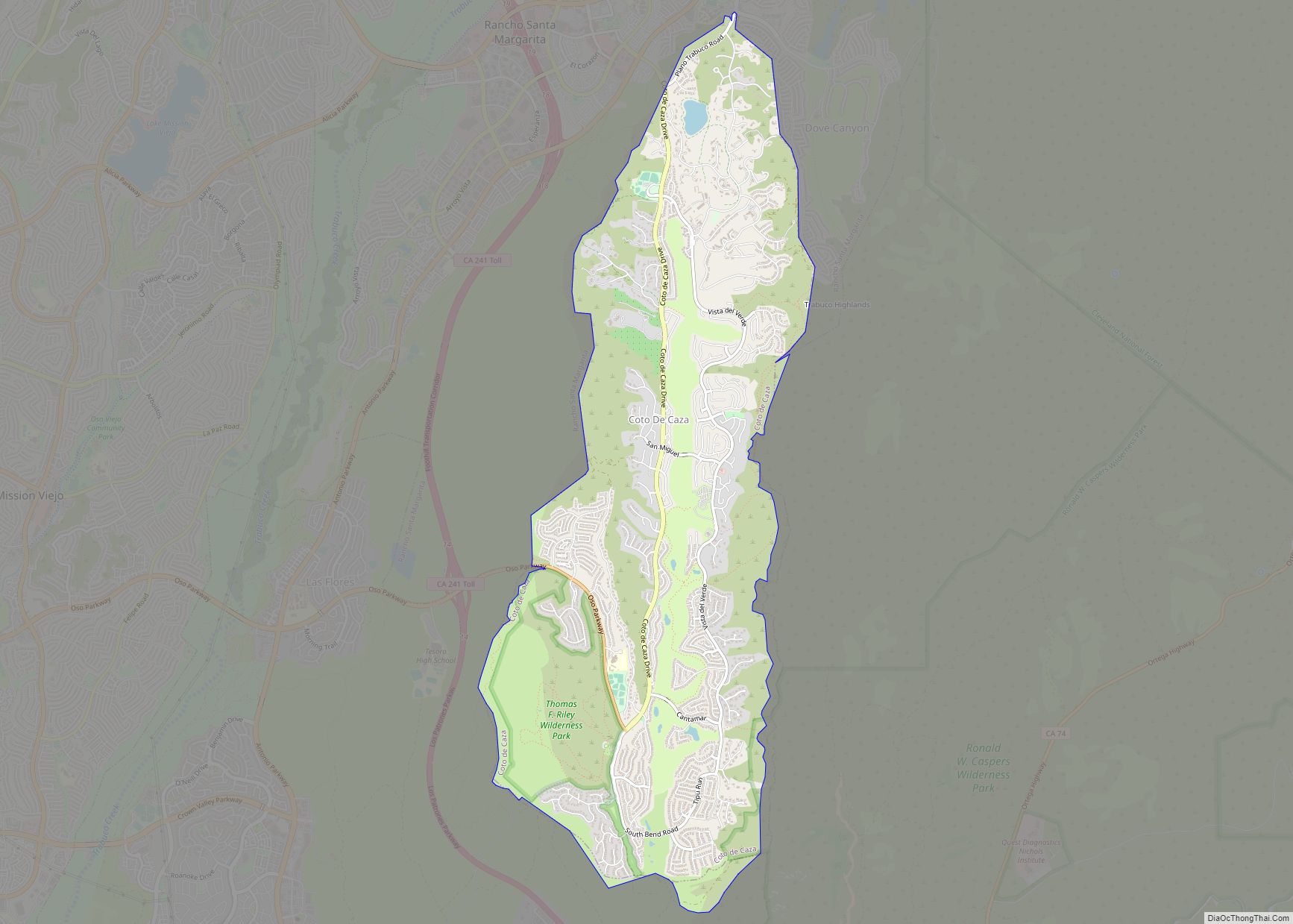Orange County, often known by its initials O.C., is located in the Los Angeles metropolitan area in Southern California. As of the 2020 census, the population was 3,186,989, making it the third-most-populous county in California, the sixth-most-populous in the United States, and more populous than 19 American states and Washington, D.C. Although largely suburban, it is the second-most-densely-populated county in the state behind San Francisco County. The county’s three most-populous cities are Anaheim, Santa Ana, and Irvine, each of which has a population exceeding 300,000. Santa Ana is also the county seat. Six cities in Orange County are on the Pacific coast: Seal Beach, Huntington Beach, Newport Beach, Laguna Beach, Dana Point, and San Clemente.
Orange County is included in the Los Angeles-Long Beach-Anaheim Metropolitan Statistical Area. The county has 34 incorporated cities. Older cities like Tustin, Santa Ana, Anaheim, Orange, and Fullerton have traditional downtowns dating back to the 19th century, while newer commercial development or “edge cities” stretch along the Interstate 5 (Santa Ana) Freeway between Disneyland and Santa Ana and between South Coast Plaza and the Irvine Business Complex, and cluster at Irvine Spectrum. Although single-family homes make up the dominant landscape for most of the county, Northern and Central Orange County is relatively more urbanized and dense as compared to those areas south of Irvine, which are less dense, though still contiguous and primarily suburban rather than exurban.
The county is a tourist center, with attractions like Disneyland, Knott’s Berry Farm, Mission San Juan Capistrano, Huntington Beach Pier, Modjeska House, Segerstrom Center for the Arts, Yost Theater, Bowers Museum, Balboa Island, Angel Stadium, Downtown Santa Ana, Crystal Cove Historic District, the Honda Center, the Old Orange County Courthouse, the Irvine Ranch Natural Landmarks, and several popular beaches along its more than 40 mi (64 km) of coastline. It is also home to a major research university, the University of California, Irvine (UCI), along with a number of other notable colleges and universities such as Chapman University and Cal State Fullerton.
| Name: | Orange County |
|---|---|
| FIPS code: | 06-059 |
| State: | California |
| Founded: | 1889 |
| Named for: | The orange, named so the county would sound like a semi-tropical, mediterranean region to people from the east coast |
| Seat: | Santa Ana |
| Largest city: | Anaheim (population) Irvine (area) |
| Total Area: | 948 sq mi (2,460 km²) |
| Land Area: | 799 sq mi (2,070 km²) |
| Total Population: | 3,186,989 |
| Population Density: | 3,989/sq mi (1,540/km²) |
| Time zone: | UTC−8 (Pacific Time Zone) |
| Summer Time Zone (DST): | UTC−7 (Pacific Daylight Time) |
| Website: | ocgov.com |
Orange County location map. Where is Orange County?
History
Indigenous
Archeological evidence shows the area to have been inhabited beginning about 9,500 years ago. At the time of European contact, the northern area of what is now Orange County was primarily inhabited by the Tongva, a part of Tovaangar, while the southern area of the county, below Aliso Creek, was primarily inhabited by the Acjachemen. Both groups lived in villages throughout the area. Large villages were sometimes multiethnic and multilingual, such as Genga, located in what is now Newport Beach. The village was shared by the Tongva and Acjachemen. The village of Puhú was located in what is now Black Star Canyon and was shared by multiple groups, including the Tongva, Acjachemen, Serrano and Payómkawichum.
The mother village of the Acjachemen was Putiidhem and is now located in San Juan Capistrano underneath Junipero Serra Catholic High School. For the Tongva, north Orange County was at the southern extent of their village sites. In coastal villages like Lupukngna, at least 3,000 years old located in what is now Huntington Beach, villagers likely used te’aats or plank boats to navigate the coastline, with fish and shellfish being more central to the diet. In inland villages such as Hutuknga, rabbit and mule deer were more central, in addition to acorns from oak trees and seeds from grasses and sage bushes common everywhere.
Spanish mission period
After the 1769 expedition of Gaspar de Portolà, a Spanish expedition led by Junipero Serra named the area Valle de Santa Ana (Valley of Saint Anne). On November 1, 1776, Mission San Juan Capistrano became the area’s first permanent European settlement. Among those who came with Portolá were José Manuel Nieto and José Antonio Yorba. Both these men were given land grants—Rancho Los Nietos and Rancho Santiago de Santa Ana, respectively.
The Nieto heirs were granted land in 1834. The Nieto ranches were known as Rancho Los Alamitos, Rancho Las Bolsas, and Rancho Los Coyotes. Yorba heirs Bernardo Yorba and Teodosio Yorba were also granted Rancho Cañón de Santa Ana (Santa Ana Canyon Ranch) and Rancho Lomas de Santiago, respectively. Other ranchos in Orange County were granted by the Mexican government during the Mexican period in Alta California.
Saint Junípero Serra y Ferrer and the early components of the Portolá Expedition arrived in modern-day San Diego, south of the present-day Orange County, in mid-late 1769. During these early Mission years, however, the early immigrants continued to rely on imports of both Mexican-grown and Spanish-grown wines; Serra repeatedly complained of the process of repeated, labored import. The first grape crop production was produced in 1782 at San Juan Capistrano, with vines potentially brought through supply ships in 1778.
19th century
Viticulture became an increasingly important crop in Los Angeles and Orange Counties through the subsequent decades. By the 1850s, the regions supported more than 100 vineyards. In 1857, Anaheim was founded by 50 German-Americans (with lineage extending back to Franconia) in search of a suitable grape-growing region. This group purchased a 1,165 acres (4.71 km2) parcel from Juan Pacifico Ontiveros’s Rancho San Juan Cajon de Santa Ana for $2 per acre and later formed the Anaheim Vineyard Company. With surveyor George Hansen, two of the wine colony’s founders, John Frohling and Charles Kohler, planted 400,000 grapevines along the Santa Ana River; by 1875, “there were as many as 50 wineries in Anaheim, and the city’s wine production topped 1 million gallons annually.” Despite later afflictions of both Phylloxera and Pierce’s Disease, wine growing is still practiced.
A severe drought in the 1860s devastated the prevailing industry, cattle ranching, and much land came into the possession of Richard O’Neill Sr. James Irvine and other land barons. In 1887, silver was discovered in the Santa Ana Mountains, attracting settlers via the Santa Fe and Southern Pacific Railroads. High rates of Anglo migration gradually moved Mexicans into colonias, or segregated ethnic enclaves.
After several failed attempts in previous sessions, the California legislature passed a bill authorizing the portion of Los Angeles County south of Coyote Creek to hold a referendum on whether to remain part of Los Angeles County or to secede and form a new county to be named “Orange” as directed by the legislature. The referendum required a 2/3 vote for secession to take place, and on June 4, 1889, the vote was 2,509 to 500 in favor of secession. After the referendum, Los Angeles County filed three lawsuits to prevent the secession, but their attempts were futile.
On July 17, 1889, a second referendum was held south of the Coyote Creek to determine if the county seat of the new county would be Anaheim or Santa Ana, along with an election for every county officer. Santa Ana defeated Anaheim in the referendum. With the referendum having passed, the County of Orange was officially incorporated on August 1, 1889. Since the incorporation of the county, the only geographical changes made to the boundary was when the County and Los Angeles County traded some parcels of land around Coyote Creek to conform to city blocks.
The county is said to have been named for the citrus fruit in an attempt to promote immigration by suggesting a semi-tropical paradise – a place where anything could grow.
20th century
Other citrus crops, avocados, and oil extraction were also important to the early economy. Orange County benefited from the July 4, 1904, completion of the Pacific Electric Railway, a trolley connecting Los Angeles with Santa Ana and Newport Beach. The link made Orange County an accessible weekend retreat for celebrities of early Hollywood. It was deemed so significant that Pacific City changed its name to Huntington Beach in honor of Henry E. Huntington, president of the Pacific Electric and nephew of Collis Huntington. Transportation further improved with the completion of the State Route and U.S. Route 101 (now mostly Interstate 5) in the 1920s.
In the 1910s, agriculture in Orange County was largely centered on grains, hay, and potatoes by small farmers, accounting for 60% of the county’s exports. The Segerstroms and Irvines once produced so many lima beans that the county was called “Beanville”. By 1920, fruit and nut exports exploded, which led to the increase of industrialized farming and the decline of family farms. For example, by 1917, William Chapman came to own 350,000 acres in northeastern Orange County from the Valencia orange. Around the 1910s and 1920s, most of the barrios of Orange County, such as in Santa Ana, further developed as company towns of Mexican laborers, who worked in the industrial orange groves. Poor working conditions resulted in the Citrus Strike of 1936, in which more than half of the orange industry’s workforce, largely Mexican, demanded better working conditions. The strike was heavily repressed, with forced evictions and state-sanctioned violence being used as tactics of suppression. Carey McWilliams referred to the suppression as “the toughest violation of civil rights in the nation.”
The Los Angeles flood of 1938 devastated some areas of Orange County, with most of the effects being in Santa Ana and Anaheim, which were flooded with six feet of water. As an eight-foot-high rush of water further spilled out of the Santa Ana Canyon, forty-three people were killed in the predominately Mexican communities of Atwood and La Jolla in Placentia. The devastation from this event, as well as from the 1939 California tropical storm, meant that Orange County was in need of new infrastructure, which was supported by the New Deal. This included the construction of numerous schools, city halls, post offices, parks, libraries, and fire stations, as well as the improvement of road infrastructure throughout Orange County.
School segregation between Mexican and white students in Orange County was widespread in the mid 1940s, with 80% of Mexican students attending 14 segregated schools. These schools taught Mexican children manual education – or gardening, bootmaking, blacksmithing, and carpentry for Mexican boys and sewing and homemaking for girls – while white schools taught academic preparation. The landmark case Mendez vs. Westminster (1947) desegregated Orange County schools, after the Mendez family were denied enrollment into the 17th Street School in Westminster in 1944, despite their cousins with lighter skin being admitted, and were instead told to enroll at the Hoover Elementary School for Mexican children.
In the 1950s, agriculture, such as that involving the boysenberries made famous by Buena Park native Walter Knott, began to decline. However, the county’s prosperity soared during this time. The completion of Interstate 5 in 1954 helped make Orange County a bedroom community for many who moved to Southern California to work in aerospace and manufacturing. Orange County received a further economic boost in 1955 with the opening of Disneyland.
In 1969, Yorba Linda-born Orange County native Richard Nixon became the 37th President of the United States.
In the late 1970s, Vietnamese and Latino immigrants began to populate central Orange County.
In the 1980s, Orange County had become the second most populous county in California as the population topped two million for the first time.
In the 1990s, red foxes became common in Orange County as a non-native mesopredator, with increasing urban development pushing out coyote and mountain lion populations to the county’s shrinking natural areas.
In 1994, an investment fund meltdown led to the criminal prosecution of treasurer Robert Citron. The county lost at least $1.5 billion through high-risk investments in bonds. The loss was blamed on derivatives by some media reports. On December 6, 1994, the County of Orange declared Chapter 9 bankruptcy, from which it emerged on June 12, 1996. The Orange County bankruptcy was at the time the largest municipal bankruptcy in U.S. history.
Land use conflicts arose between established areas in the north and less developed areas in the south. These conflicts were over issues such as construction of new toll roads and the repurposing of a decommissioned air base. El Toro Marine Corps Air Station was designated by a voter measure in 1994 to be developed into an international airport to complement the existing John Wayne Airport. But subsequent voter initiatives and court actions have caused the airport plan to be permanently shelved. It has developed into the Orange County Great Park and housing.
21st century
In the 21st century, the social landscape of Orange County has continued to change. The opioid epidemic saw a rise in Orange County, with unintentional overdoses becoming the third highest contributor of deaths by 2014. As in other areas, the deaths disproportionately occurred in the homeless population. However, deaths were widespread among affluent and poorer areas in Orange County, with the highest at-risk group being Caucasian males between the ages of 45-55. A 2018 study found that supply reduction was not sufficient to preventing deaths.
In 2008, a report issued by the Orange County Superior Court found that the county was experiencing a pet “overpopulation problem,” with the growing number of pets leading to an increase in euthanasias at the Orange County Animal Shelter to 13,000 for the year alone.
Following the 2016 presidential election, Santa Ana become a sanctuary city for immigrants. This created an intense debate in Orange County surrounding politics toward immigration, with many cities opposing pro-immigration policies.
The COVID-19 pandemic in Orange County disproportionately affected lower income and Latino residents.
Implementation of renewable energy and climate change awareness in Orange County increased, with the city of Irvine pledging to be a zero-carbon economy by 2030 and Buena Park, Huntington Beach, and Fullerton pledging to move to 100% clean energy. Residential solar panel installation has rapidly increased, even among middle-income families, as a result of the state’s residential solar program which began in 2006.
In the 2010s, campaigns to conserve remaining natural areas gained awareness. By the early 2020s, some success was found, with the conservation of 24 acres in the West Coyote Hills of a total 510 acres and the Genga/Banning Ranch project moving forward, conserving some 385 acres, which was part of the Tongva village area of Genga. In 2021, the commemorative 1.5 acre Putuidem village opened after years of delays and campaigning by the Acjachemen.
Orange County Road Map
Geography
According to the U.S. Census Bureau, the county has a total area of 948 sq mi (2,460 km), of which 791 sq mi (2,050 km) is land and 157 sq mi (410 km) (16.6%) is water. It is the smallest county by area in Southern California, being just over 40% the size of the region’s next smallest county, Ventura. The average annual temperature is about 68 °F (20 °C).
Orange County is bordered on the southwest by the Pacific Ocean, on the north by Los Angeles County, on the northeast by San Bernardino County, on the east by Riverside County, and on the southeast by San Diego County.
The northwestern part of the county lies on the coastal plain of the Los Angeles Basin, while the southeastern end rises into the foothills of the Santa Ana Mountains. Most of Orange County’s population reside in one of two shallow coastal valleys that lie in the basin, the Santa Ana Valley and the Saddleback Valley. The Santa Ana Mountains lie within the eastern boundaries of the county and of the Cleveland National Forest. The high point is Santiago Peak (5,689 ft (1,734 m)), about 20 mi (32 km) east of Santa Ana. Santiago Peak and nearby Modjeska Peak, just 200 ft (60 m) shorter, form a ridge known as Saddleback, visible from almost everywhere in the county. The Peralta Hills extend westward from the Santa Ana Mountains through the communities of Anaheim Hills, Orange, and ending in Olive. The Loma Ridge is another prominent feature, running parallel to the Santa Ana Mountains through the central part of the county, separated from the taller mountains to the east by Santiago Canyon.
The Santa Ana River is the county’s principal watercourse, flowing through the middle of the county from northeast to southwest. Its major tributary to the south and east is Santiago Creek. Other watercourses within the county include Aliso Creek, San Juan Creek, and Horsethief Creek. In the North, the San Gabriel River also briefly crosses into Orange County and exits into the Pacific on the Los Angeles-Orange County line between the cities of Long Beach and Seal Beach. Laguna Beach is home to the county’s only natural lakes, Laguna Lakes, which are formed by water rising up against an underground fault.
Regions of Orange County
Orange County is sometimes divided into northern and southern regions. There are significant political, demographic, economic and cultural distinctions between North and South Orange County. A popular dividing line between the two regions is the Costa Mesa Freeway.
North Orange County, including Anaheim, Fullerton, Garden Grove and Santa Ana, was the first part of the county to be developed and is culturally closer to neighboring Los Angeles County. This region is more Hispanic (mostly Mexican) and Asian (predominantly Vietnamese and Korean), more densely populated (Santa Ana is the fifth most densely-populated city in the United States with a population of over 200,000), younger, less wealthy and with higher unemployment. It has more renters and fewer homeowners and generally votes Democratic. There are notable exceptions to these general trends, such as strongly Republican Yorba Linda and affluent Anaheim Hills, North Tustin, and Villa Park. North Orange County is predominantly flat, giving way to the Santa Ana Mountains in the Northeast.
South Orange County is wealthier, more residential, more Republican, predominantly non-Hispanic white and more recently developed. Irvine, the largest city in the region, is an exception to some of these trends, being not only a major employment center, but also a major tech hub and education center with UCI. Furthermore, the city is an Asian plurality (both South and East Asian), and votes reliably Democratic in recent years. South Orange County almost always includes Irvine, Newport Beach, and the cities to their southeast, including Lake Forest, Laguna Beach, Mission Viejo, and San Clemente. Alternatively, Irvine and Newport Beach are sometimes seen as Central Orange County, acting as a transition zone between north and south; when this viewpoint is taken Tustin is also considered to be in central Orange County. Costa Mesa is sometimes included in South County, although it is located predominantly to the west of the Costa Mesa Freeway and is part of the even street grid network of north Orange County. Irvine is located in a valley defined by the Santa Ana Mountains and the San Joaquin Hills, while much of South Orange County is very hilly.
Another region of Orange County is the Orange Coast, which includes the six cities bordering the Pacific Ocean. These are, from northwest to southeast: Seal Beach, Huntington Beach, Newport Beach, Laguna Beach, Dana Point and San Clemente, although Seal Beach is sometimes viewed as an extension of neighboring Long Beach in Los Angeles County.
Commercial clusters — edge cities
Older cities like Santa Ana, Anaheim, and Fullerton have traditional downtowns dating back to the 19th century, with Downtown Santa Ana being the home of the county, state and federal institutions. However, far more commercial activity is concentrated in clusters of newer commercial development are found in the county’s edge cities, the three largest being
- along Interstate 5 between Disneyland and Downtown Santa Ana
- South Coast Plaza to the Irvine Business Complex, and at
- Irvine Spectrum
A contiguous strip of commercial development (an edge city) stretches from Disneyland through to MainPlace Mall along the I-5 Santa Ana Freeway, straddling the city limits of Anaheim, Garden Grove, Orange, and Santa Ana, and in fact stretching between the original downtowns of those four cities.
Entertainment and cultural facilities include Disneyland Resort, Angel Stadium, Christ Cathedral (formerly Crystal Cathedral), City National Grove of Anaheim – a live concert venue, Discovery Cube Orange County, the Honda Center – home to the Anaheim Ducks of the NHL (National Hockey League), and the Anaheim Convention Center. Health care facilities include CHOC (Children’s Hospital of Orange County), Kaiser Permanente Health Pavilion (Anaheim), St. Joseph Hospital (Orange), and the UCI Medical Center.
Retail complexes include Anaheim GardenWalk, Anaheim Marketplace (claiming to be the largest indoor swap meet in Orange County with more than 200 vendors), MainPlace Mall, Orange Town & Country, and The Outlets at Orange, originally a mall named “The City” which was the centerpiece of a planned, 1970s mixed-use development by the same name. There is commercial strip-style development including big box retailers along West Chapman Avenue in Orange (Marshalls, Ralphs), along Harbor Boulevard in Garden Grove (Burlington, Ross Dress for Less), and around Harbor Blvd. and Chapman Ave. in Anaheim (Target).
Major hotels line Harbor Boulevard from Disneyland south to Garden Grove: Grand Legacy at the Park, Hilton, Marriott, Courtyard, DoubleTree Suites, Hampton Inn, Hilton Garden Inn, Homewood Suites, Embassy Suites, Residence Inn, Hyatt Regency, Marriott Suites, Sheraton, and the Great Wolf Lodge. The Orange County Transit Authority studied the corridor as the possible route for a streetcar, a proposal that was dropped in 2018 due to opposition from Anaheim and other city governments.
In addition to suburban-style apartment complexes, Anaheim’s Platinum Triangle is undergoing transformation from a low-density commercial and industrial zone into a more urban environment with high-density housing, commercial office towers, and retail space. Anaheim envisions it as a “downtown for Orange County”. The 820 acres (330 ha) area undergoing this large-scale redevelopment includes the city’s two major sports venues, the Honda Center and Angel Stadium of Anaheim.
National protected areas
- Cleveland National Forest (part)
- Seal Beach National Wildlife Refuge
